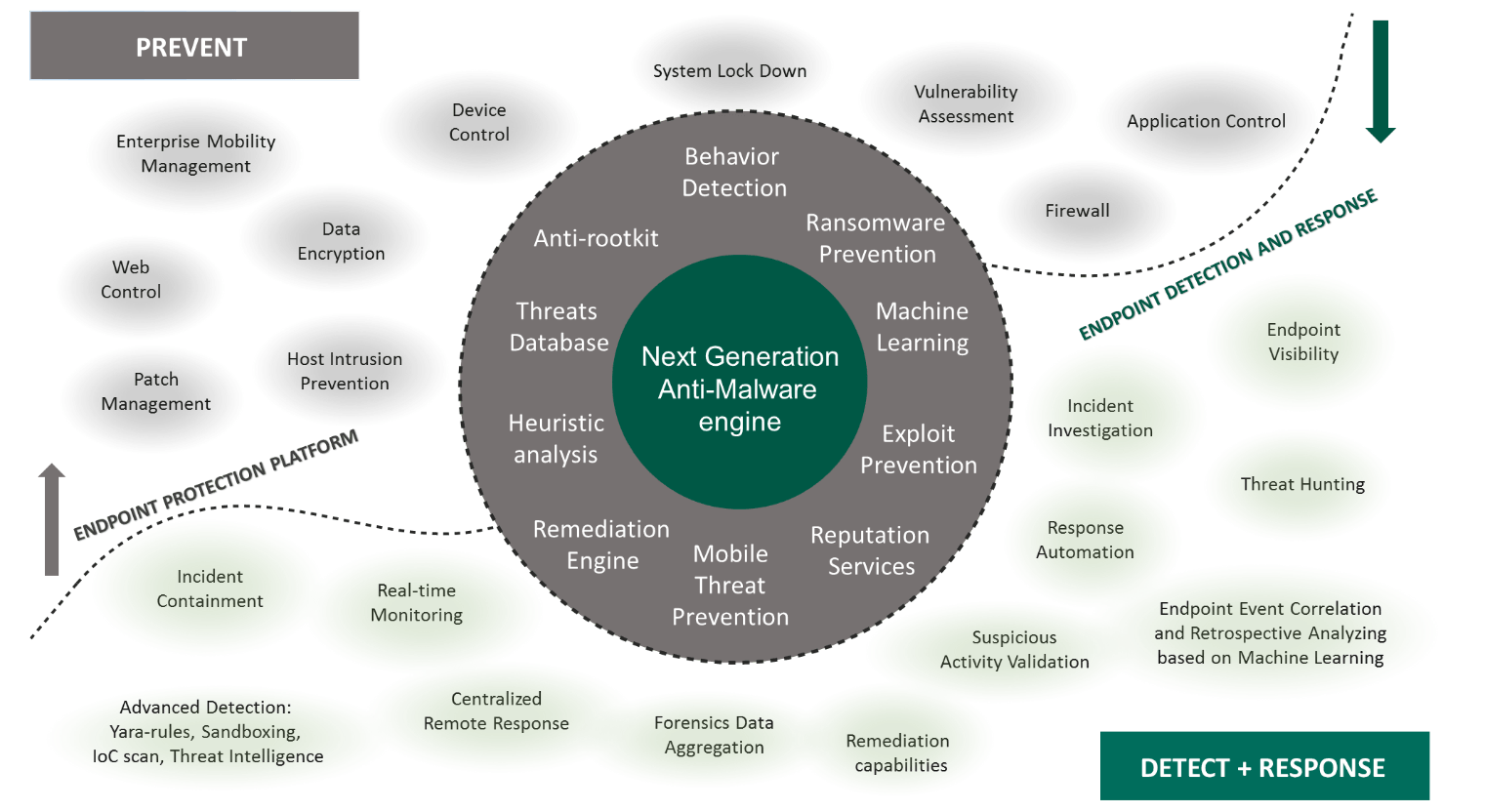EPP vs. EDR: What Matters More, Prevention or Response?
If you were the mayor of a major city, what would you value more? Police cars that can identify issues in traffic and prevent accidents, or ambulances that can race to the scene of an accident, respond to a crisis, and save lives?
Endpoint Protection Platforms (EPP) help prevent security threats, including known and unknown malware, on your endpoint devices. Endpoint Detection and Response (EDR) solutions help you detect and respond to incidents that managed to bypass your EPP or other security measures. When it comes to comparing EPP vs EDR, which is more important? Can you do without one or the other?
Many modern EPP platforms combine the two approaches, offering both threat prevention and EDR. Still, you can choose which components to deploy on which endpoints, and there may be separate pricing for different parts of the EPP package. So the question of prevention vs. response is still a relevant one.
Click here to learn more about Extended Detection and Response (XDR) – the next stage in the evolution of EPP and EDR.
What is EPP?
Endpoint Protection Platforms are designed to prevent attacks from traditional threats, such as known malware, and advanced threats such as ransomware, zero-day vulnerabilities, and fileless attacks.
As mentioned, many EPP platforms include EDR, but in this discussion we focus on “pure” EPP security capabilities excluding EDR.
An EPP detects malicious activity using several methods:
- Signature matching – identifying threats using a known malware signature.
- ML static analysis – analyzing binaries prior to execution using machine learning algorithms and searching for malicious attributes.
- Sandboxing – executing files in a virtual environment to inspect for malicious behavior before allowing them to run.
- Blacklisting and whitelisting – blocking access or only permitting access to specific applications, IP addresses, URLs or ports.
- Behavioral analysis – modern EPP can establish a behavioral baseline of endpoint behavior and identify processes or users that are behaving abnormally, even though there is no known threat signature.
EPPs can provide the following tools, which provide passive protection for an endpoint:
- Antivirus and Next-Generation Antivirus (NGAV) – Tools for the identification and blocking of malware and other software threats. Traditional antivirus uses signature-based detection to identify known malware strains, while NGAV leverages machine learning, behavioral analysis, and threat intelligence to detect and prevent advanced, evolving threats, like fileless attacks and zero-days.
- Personal firewall protecting the endpoint – A tool for controlling, inspecting, and governing incoming and outgoing network traffic on an endpoint. This helps block unauthorized access and isolate suspicious network activity from malware or attackers.
- Data encryption, possibly with some data loss prevention capabilities – Making data unreadable to anyone with a decryption key, i.e, attackers, business competitors, and insider threats. When combined with Data Loss Prevention (DLP), it can also prevent unauthorized sharing or exfiltration of confidential data.
What is EDR?
Endpoint Detection and Response (EDR) was defined by Gartner in 2013 as a new type of security technology. It helps detect attacks on endpoint devices and provides fast access to information about the attack. This is difficult to achieve without EDR technology because security staff typically have low visibility and little to no control over remote endpoints.
Beyond providing access to information, a key role of EDR software is to help security staff respond to attacks by quarantining an endpoint, blocking processes, or running automatic incident response playbooks.
EDR solutions have three main components:
- Data collection—software agents on endpoint devices collect data about process execution, communication, and logins.
- Detection engine—analyzes typical endpoint activity, discovers anomalies, and reports anomalies that may represent a security incident on the endpoint.
- Data analysis engine—aggregates data from endpoints and provides real-time analytics about security incidents from across the enterprise.
Most EDR solutions also provide:
- Threat intelligence—identifying Indicators of Compromise (IoCs) on the endpoint and identifying the likely threat actor and the attack technique they are using.
- Alerts and forensics—notifying security staff in real time about security incidents and giving them easy access to context that will help fully investigate the incident.
- Trace back—helps security staff identify which other endpoints or network devices may be affected by the same attack and where the attacker originally penetrated the network.
- Automated response—performing actions on the endpoint device, such as blocking network access, blocking a process, or other actions that can contain and mitigate the attack.
EPP vs. EDR: Main Differences
There are a few key differences between “pure” EPP and EDR, although these differences are blurring as many vendors merge EPP and EDR into one system.
| EPP | EDR | |
| Line of Defense | First-line defense mechanism that prevents threats | Assumes a breach has already occurred and helps investigate and contain it |
| Detection Methods | Signature-based detection, heuristics, sandboxing, and basic behavioral analysis | Continuous monitoring of endpoint activity, advanced behavioral analytics, threat intelligence, and anomaly detection |
| Human Involvement | Does not require active supervision | Used actively by security staff to respond to incidents |
| Threat Detection and Response | Responsive threat prevention | Active threat detection |
| Visibility | Does not provide visibility into activity on the endpoint | Helps security teams aggregate event data from endpoints across the enterprise |
| Threat Coverage | Able to prevent known threats and some unknown threats | Enables immediate response to threats that EPP could not detect |
| Scalability | Focused on protecting each endpoint in isolation | Provides data and context for attacks spanning multiple endpoints |
EPP vs. EDR: Which One Should You Choose?
If you were forced to choose between them, which should you choose?
- Choosing EPP: EPP is critical because it can protect against “commodity” threats and also many advanced threats. Like a sophisticated lock on your door, it doesn’t prevent a burglary but makes it much more difficult for attackers to penetrate your perimeter. In many cases attackers will prefer other, easier targets and avoid the major effort involved in overcoming EPP defenses.
- Choosing EDR: EDR is critical because it provides the visibility and operational tools that allow security teams to react to an attack. Many attacks, especially Advanced Persistent Threats (APTs), focus on endpoints as a weak link in the security perimeter. EDR can dramatically reduce the time needed to detect successful attacks on endpoints, contain them and identify the full kill chain that led the attacker to a specific device.
- Choosing Both: Analysts advise using a combination of “pure” EPP and EDR to protect endpoints. EPP is a first line of defense that can prevent threats before they hit the endpoint, while EDR is based on the “assumption of breach”, the understanding that you can never assume complete protection, and must have the means to effectively respond to a successful attack.
As a mayor of a city, you wouldn’t want to choose between police cars and ambulances. The absence of each would put citizens at risk and inevitably result in lives lost. Similarly, when building your suite of security solutions, you need to ensure you have a mix of prevention and detection to keep users and enterprise systems safe.
EPP and EDR in the Security Stack: How They Work Together
Both EPP and EDR are foundational layers in endpoint security. EPP focuses on prevention. This means blocking known threats like malware, ransomware, and fileless attacks using signature-based detection, behavioral analysis, and machine learning. EDR picks up where EPP stops: it provides detection, investigation, and response capabilities for advanced threats that bypass preventive controls.
When combined in the broader security stack:
- SIEM (Security Information and Event Management) platforms collect telemetry data from EPP, EDR, and other tools for centralized log analysis and threat correlation.
- SOAR (Security Orchestration, Automation, and Response) tools use EPP/EDR alerts to automate incident response workflows.
- XDR (Extended Detection and Response) extends EDR capabilities by monitoring and responding across networks, identities, and cloud systems, on top of endpoints.
- MDR (Managed Detection and Response) providers often deploy their own EPP/EDR agents (or integrate with existing ones) to deliver 24/7 threat hunting, alert triage, and expert-guided response.
Tips From Expert
- Prioritize layered defense by integrating EPP and EDR
Rather than choosing one over the other, ensure your strategy layers EPP’s preventive controls with EDR’s detection and response capabilities. This multi-layered defense is crucial for catching both common threats and sophisticated attacks that evade traditional prevention. - Automate playbook-driven response for EDR alerts
Automate common incident response actions based on predefined playbooks in your EDR platform. Automating steps like endpoint isolation or process termination allows for faster containment, minimizing the dwell time of detected threats. - Enable continuous endpoint monitoring across all devices
While EPP focuses on passive protection, use EDR for continuous monitoring of endpoint behaviors, even those devices that appear healthy. This provides an extra layer of defense, allowing security teams to detect subtle signs of compromise that may slip past prevention layers. - Leverage EDR’s root cause analysis for prevention improvements
Use data collected from EDR investigations to enhance your EPP configurations. For example, if EDR catches a specific attack that bypassed your EPP, you can adjust prevention rules or add indicators of compromise (IOCs) to better prevent similar future incidents. - Use EDR to enhance incident response (IR) workflows
Integrate EDR data into your broader IR workflows, including SIEM and SOAR platforms. EDR’s granular endpoint data can enrich your overall security insights, providing faster, more coordinated responses when incidents span multiple systems or involve complex attack chains.
How can Cynet help with EPP and EDR
Cynet is a comprehensive security solution that protects against threats to endpoint security and across your network. Cynet’s intelligent technologies can help you detect attacks by correlating information from endpoints, network analytics, and behavioral analytics with almost no false positives.
Cynet combines both EPP and EDR solutions in its All-in-One cybersecurity platform. Cynet is the only vendor that delivered BOTH 100% Visibility and 100% Protection with no configuration changes in the highly respected 2025 MITRE ATT&CK Evaluation: Enterprise.
Cynet’s platform includes:
- NGAV—providing automated prevention and termination of malware, exploits, Macros, LOLBins, and malicious scripts with machine learning based analysis.
- User Behavior Analytics (UBA)—detecting and preventing attacks using compromised credentials through the use of behavioral baselines and signatures.
- Deception technology—planting fake credentials, files, and connections to lure and trap attackers, mitigating damage, and providing the opportunity to learn from attacker activity.
- Network analytics—preventing and detecting network-based attacks through assessment of credential use, lateral movement, and risky connections.
- Monitoring and control—providing asset management, vulnerability assessments, and application control with continuous monitoring and log collection.
- Response orchestration—providing manual and automated remediation for files, users, hosts, and networks customized with user-created scripts.
Learn more about the Cynet security platform.
FAQs
EPP is designed to prevent known threats from compromising endpoints using tools like antivirus, anti-malware, and personal firewalls. They rely on signature-based detection and behavioral heuristics to block threats before execution. EDR focuses on detecting and responding to threats that have already bypassed preventive controls. EDR provides advanced threat hunting, incident response, and forensics by continuously monitoring endpoint activities and recording system behaviors to identify suspicious patterns or anomalies.
Yes, and in fact, this is the recommended approach for modern endpoint security. EPP acts as the first line of defense, blocking common threats before they execute. EDR complements this by detecting and containing more sophisticated or stealthy attacks that may have slipped through, such as fileless malware or insider threats. Many security vendors, like Cynet, now offer integrated EPP and EDR solutions. This allows for seamless coordination between prevention, detection, and response.
While EPP is essential for baseline protection, it is not sufficient on its own. Modern attacks often use techniques that evade traditional EPP defenses, such as living-off-the-land binaries (LOLBins), zero-days, or multi-stage attacks. EDR adds the ability to investigate suspicious activity in real-time, trace the root cause of an incident, and take corrective action quickly.
EDR uses a combination of continuous monitoring of endpoint activity, advanced behavioral analytics, threat intelligence, and anomaly detection to uncover threats that lack known signatures. By continuously collecting telemetry from endpoints, EDR platforms can detect deviations from normal patterns. Some EDR tools also integrate with threat intelligence feeds and MITRE ATT&CK frameworks to spot tactics and techniques used by attackers, even if the exact malware strain is new.
EPP solutions are effective at blocking threats like viruses, trojans, worms, spyware, adware, phishing, ransomware, malware, account takeovers, and more. They can mitigate both CVEs and zero-days.
EPP tools attempt to block zero-day threats using heuristics, sandboxing, threat intelligence, and exploit prevention techniques. EDR, on the other hand, doesn’t rely on prior knowledge; it monitors how code behaves after execution. When abnormal activity is detected, EDR can alert analysts or trigger automated responses. The combination of proactive blocking by EPP and reactive detection by EDR provides a stronger defense against zero-days.
Smaller businesses with limited budgets might start with a strong EPP solution, especially one with next-gen capabilities like behavioral analytics. However, if your organization faces targeted attacks, handles sensitive data, or is subject to compliance regulations, it is recommended to include EDR as well. Ideally, opt for an integrated EPP+EDR platform or an MDR service if you lack the internal expertise to manage an EDR system effectively.
Related Posts
Looking for a powerful, cost effective XDR solution?
- Full-Featured XDR, EDR, and NGAV
- Anti-Ransomware & Threat Hunting
- 24×7 Managed Detection and Response







